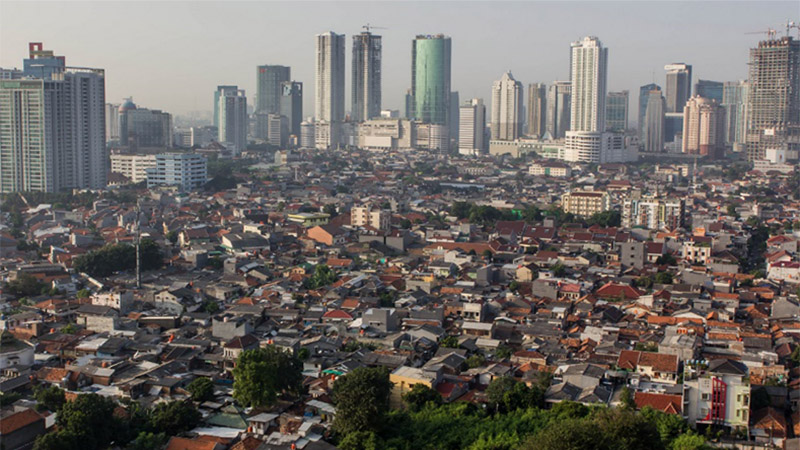Indonesia is rich in energy resources, including coal, natural gas, biofuels and geothermal energy, but its booming population still struggles with poverty, unemployment and energy access.
The country’s gross national income was just US$3,630 per person in 2014 and annual growth is just around 5% – both below the regional average.
Along with corruption, poor infrastructure is a key barrier to development. So when President Joko (“Jokowi”) Widodo took office in 2014, he set out to boost investment in infrastructure by 53%.
It was the largest year-on-year increase in Indonesia’s history, part of an effort to achieve a 7% GDP growth rate. Widodo’s agenda required capital – and the country’s wasteful fossil fuel subsidy budget was the perfect source to draw upon.
Removing fuel subsidies, pegging domestic fuel prices to the global oil market, and reallocating the budget to infrastructure investment, particularly in the energy sector, also fit with the advice of the World Bank and the Asian Development Bank.
Weekly briefing: Sign up for your essential climate politics update
And it was consistent with longstanding advice to reform subsidies and remove price controls to balance current account deficits.
Subsidies on imported fuels have created historic budget deficits and made the economy vulnerable to volatility in the oil and currency exchange markets.
So starting in late 2014, Widodo began to cut fuel subsidies, particularly to petroleum, projecting that this would free up IDR195 trillion (US$15.6 billion) from the 2015 budget’s original allocation of IDR276.0 trillion (US$22.1 billion) to be used instead on mainly infrastructure investments.
The reforms were widely praised as a success, not least because, unlike past reforms that led to massive protests, they were accepted by the public.
However, Indonesia had set itself up for future fiscal troubles.
There are inconsistencies in how the reforms were presented, and what happened in reality. The fossil fuel subsidy reforms coincided with the crash of the global oil market, which some scholars argued was the best moment to introduce reforms, since price shocks would be low.
But then the rupiah depreciated to IDR 13,271 to US$1, levels not seen since the Asian financial crisis.
Since the removal of subsidies was passed by Parliament and signed into law in 2015, the 2016 budget did not include a budget line for gasoline subsidies, but it kept subsidies for 3 kg LPG tanks, diesel and renewable energy.
And instead of being removed completely, the cost of gasoline subsidies was transferred to Pertamina, the state-owned oil company, which now covers the difference between the subsidized price set by the government and market price of fuel.
The Indonesian government did not reimburse Pertamina for losses from price controls during 2015, which amounted to US$1 billion (IDR 15 trillion).
In March 2016, the government also cut subsidized fuel prices by IDR 500 (US$0.04) to reduce transportation fares by 3%. This casts further doubts on the “stickiness” of the recent reforms and has added to Pertamina’s deficit.
If Pertamina is not reimbursed, it will go bankrupt. The situation will only become more precarious if oil prices continue to rise. Since Pertamina is a state-owned enterprise, the government has a fiscal liability (and fiduciary responsibility) to recapitalize it.
Similar situations have arisen in the UK and in France, where the financial burden of nuclear subsidies were passed to EDF, which requires bailouts from the French government.
While the Indonesian government has assured Pertamina it will cover the financial losses, the Energy Security Fund being set up in part to recapitalize Pertamina is still incomplete.
In theory, the Fund would subsidize fuel prices when global crude market trades above domestic prices, using profits made while global oil prices are below Indonesia’s retail gasoline prices. This assumes that oil prices remain low.
Energy and Mineral Resources Minister Sudirman Said says the Fund will be sourced through the government budget, grants, and loans once the “legal umbrella is complete” – but it is unclear how this will be balanced against future budgetary priorities, such as social assistance and infrastructure development or how democratic this process will be.
The government’s shift in fuel subsidy reform policy is disconcerting. The lack of transparency on these policy decisions reflects either the government’s unwillingness to admit the extent of its blunder or a shift towards a less democratic process of subsidizing fuels.
Transparency, stability
Nevertheless, the fact that a fuel subsidy reform passed without major public backlash shows attitudes have changed, and there is strong potential for removing price controls.
Completing the reforms successfully will require two key elements: increased transparency and fiscal buffers to better manage volatility in the oil and currency exchange markets.
Removal of price controls requires macroeconomic stability, which in turn requires fiscal adjustments for inflation through coordinated credit, fiscal and exchange rate policies.
Such measures, combined with increased investment and directed social assistance, such as the payments set up in Iran’s subsidy reform, soften the impact of higher fuel prices and make reforms more socially acceptable.
Indonesia still has a chance to get fossil fuel subsidy reform right – but it will require political determination, strong communication campaigns and sound macroeconomic policy-making to ensure the “stickiness” of the next attempt at reforms.
Kathryn Chelminski is a doctoral research fellow in sustainability science at the Harvard Kennedy School and a PhD candidate in international relations at the Graduate Institute, Geneva.
This post is part of a series written for “The Politics of Fossil Fuel Subsidies and Their Reform“, a workshop co-hosted by Lund University and the Stockholm Environment Institute at SEI in Stockholm on 16–17 June.
